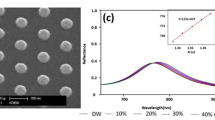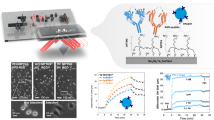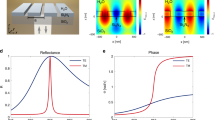Abstract
Lowering the limit of detection is key to the design of sensors needed for food safety regulations1,2, environmental policies3,4,5 and the diagnosis of severe diseases6,7,8,9,10. However, because conventional transducers generate a signal that is directly proportional to the concentration of the target molecule, ultralow concentrations of the molecule result in variations in the physical properties of the sensor that are tiny, and therefore difficult to detect with confidence. Here we present a signal-generation mechanism that redefines the limit of detection of nanoparticle sensors by inducing a signal that is larger when the target molecule is less concentrated. The key step to achieve this inverse sensitivity is to use an enzyme that controls the rate of nucleation of silver nanocrystals on plasmonic transducers. We demonstrate the outstanding sensitivity and robustness of this approach by detecting the cancer biomarker prostate-specific antigen down to 10−18 g ml−1 (4 × 10−20 M) in whole serum.
This is a preview of subscription content, access via your institution
Access options
Subscribe to this journal
Receive 12 print issues and online access
$259.00 per year
only $21.58 per issue
Buy this article
- Purchase on Springer Link
- Instant access to full article PDF
Prices may be subject to local taxes which are calculated during checkout




Similar content being viewed by others
Change history
15 December 2017
In the version of this Letter originally published, the x and y values of the data points in Fig. 2c were incorrect. The authors have also made some changes to the Supplementary Information: Fig. S9 has been replaced because the x values were incorrect; the value of the carbonate buffer concentration has been corrected to 10 mM; and the sentence on page 2 that read "Subsequently, non-reacted aldehyde sites were blocked with bovine serum albumin (BSA, 0.1 mg/mL) and ethanolamine (10 mM) in bicarbonate buffer for 1 h." has been changed to "When modifying nanostars with antibodies, non-reacted aldehyde sites were blocked with bovine serum albumin (BSA, 0.1 mg/mL) and ethanolamine (10 mM) in bicarbonate buffer for 1 h."
23 January 2018
Nature Materials 11, 604–607 (2012); published online 27 May 2012; corrected after print 15 December 2017. In the version of this Letter originally published, the x and y values of the data points in Fig. 2c were incorrect. The original and corrected versions are shown below. The authors have also made some changes to the Supplementary Information: Fig.
References
Batt, C. A. Food pathogen detection. Science 316, 1579–1580 (2007).
De la Rica, R., Baldi, A., Fernandez-Sanchez, C. & Matsui, H. Single-cell pathogen detection with a reverse-phase immunoassay on impedimetric transducers. Anal. Chem. 81, 7732–7736 (2009).
Ferber, D. Overhaul of CDC panel revives lead safety debate. Science 298, 732–732 (2002).
De la Rica, R., Mendoza, E. & Matsui, H. Bioinspired target-specific crystallization on peptide nanotubes for ultrasensitive Pb ion detection. Small 6, 1753–1756 (2010).
Li, D., Wieckowska, A. & Willner, I. Optical analysis of Hg(2+) ions by oligonucleotide-gold-nanoparticle hybrids and DNA-based machines. Angew. Chem. Int. Ed. 47, 3927–3931 (2008).
Giljohann, D. A. & Mirkin, C. A. Drivers of biodiagnostic development. Nature 462, 461–464 (2009).
Rissin, D. M. et al. Single-molecule enzyme-linked immunosorbent assay detects serum proteins at subfemtomolar concentrations. Nature Biotechnol. 28, 596–599 (2010).
Fan, R. et al. Integrated barcode chips for rapid, multiplexed analysisof proteins in microliter quantities of blood. Nature Biotechnol. 26, 1373–1378 (2008).
Laromaine, A., Koh, L. L., Murugesan, M., Ulijn, R. V. & Stevens, M. M. Protease-triggered dispersion of nanoparticle assemblies. J. Am. Chem. Soc. 129, 4156–4157 (2007).
Miranda, O. R. et al. Enzyme-amplified array sensing of proteins in solution and in biofluids. J. Am. Chem. Soc. 132, 5285–5289 (2010).
Aili, D. & Stevens, M. M. Bioresponsive peptide-inorganic hybrid nanomaterials. Chem. Soc. Rev. 39, 3358–3370 (2010).
Willner, I., Baron, R. & Willner, B. Growing metal nanoparticles by enzymes. Adv. Mater. 18, 1109–1120 (2006).
Liz-Marzan, L. M. Tailoring surface plasmons through the morphology and assembly of metal nanoparticles. Langmuir 22, 32–41 (2006).
Pejoux, C., de la Rica, R. & Matsui, H. Biomimetic crystallization of sulfide semiconductor nanoparticles in aqueous solution. Small 6, 999–1002 (2010).
Kisailus, D., Choi, J. H., Weaver, J. C., Yang, W. J. & Morse, D. E. Enzymatic synthesis and nanostructural control of gallium oxide at low temperature. Adv. Mater. 17, 314–318 (2005).
Jana, N. R., Gearheart, L. & Murphy, C. J. Evidence for seed-mediated nucleation in the chemical reduction of gold salts to gold nanoparticles. Chem. Mater. 13, 2313–2322 (2001).
Seo, J. T. et al. Optical nonlinearities of Au nanoparticles and Au/Ag coreshells. Opt. Lett. 34, 307–309 (2009).
Cardinal, M. F., Rodriguez-Gonzalez, B., Alvarez-Puebla, R. A., Perez-Juste, J. & Liz-Marzan, L. M. Modulation of localized surface plasmon and SERS response in gold dumbbells through silver coating. J. Phys. Chem. C 114, 10417–10423 (2010).
Kumar, P. S., Pastoriza-Santos, I., Rodriguez-Gonzalez, B., Garcia de Abajo, F. J. & Liz-Marzan, L. M. High-yield synthesis and optical response of gold nanostars. Nanotechnology 19, 015606 (2007).
Barbosa, S. et al. Tuning size and sensing properties in colloidal gold nanostars. Langmuir 26, 14943–14950 (2010).
Liu, M. & Guyot-Sionnest, P. Mechanism of silver(I)-assisted growth of gold nanorods and bipyramids. J. Phys. Chem. B 109, 22192–2220 (2005).
Thaxton, C. S. et al. Nanoparticle-based bio-barcode assay redefines undetectable PSA and biochemical recurrence after radical prostatectomy. Proc. Natl Acad. Sci. USA 106, 18437–18442 (2009).
Sanchez-Iglesias, A. et al. Synthesis and optical properties of gold nanodecahedra with size control. Adv. Mater. 18, 2529–2534 (2006).
Roh, K-H., Martin, D. C. & Lahann, J. Biphasic Janus particles with nanoscale anisotropy. Nature Mater. 4, 759–763 (2005).
Marinakos, S. M., Chen, S. & Chilkoti, A. Plasmonic detection of a model analyte in serum by a gold nanorod sensor. Anal. Chem. 79, 5278–5283 (2007).
De la Rica, R. & Matsui, H. Urease as a nanoreactor for growing crystalline ZnO nanoshells at room temperature. Angew. Chem. Int. Ed. 47, 5415–5417 (2008).
Kisailus, D., Schwenzer, B., Gomm, J., Weaver, J. C. & Morse, D. E. Kinetically controlled catalytic formation of zinc oxide thin films at low temperature. J. Am. Chem. Soc. 128, 10276–10280 (2006).
Tang, Z., Zhang, Z., Wang, Y., Glotzer, S. C. & Kotov, N. A. Self-assembly of CdTe nanocrystals into free-floating sheets. Science 314, 274–278 (2006).
Aili, D., Selegard, R., Baltzer, L., Enander, K. & Liedberg, B. Colorimetric protein sensing by controlled assembly of gold nanoparticles functionalized with synthetic receptors. Small 5, 2445–2452 (2009).
DeVries, G. A. et al. Divalent metal nanoparticles. Science 315, 358–361 (2007).
Acknowledgements
B. Rodrı´guez-González is thanked for electron-microscopy analysis. M.M.S. thanks the EPSRC and ERC starting investigator grant ‘Naturale’ for financial support. This research was supported by a Marie Curie Intra European Fellowship within the 7th European Community Framework Programme (R.d.l.R.). L.M.L-M. acknowledges the ERC grant ‘Plasmaquo’ for financial support. L.R-L. acknowledges an FPU scholarship from Ministerio de Educación, Spain. R.A.A-P. acknowledges financial support from CTQ2011-23167 (Ministerio de Economíca y Competitividad, Spain).
Author information
Authors and Affiliations
Contributions
R.d.l.R. elaborated the concept and designed experiments. L.R-L. performed the experiments. M.M.S. and L.M.L-M. supervised the project. All of the authors participated in scientific discussions and wrote the paper.
Corresponding authors
Ethics declarations
Competing interests
The authors declare no competing financial interests.
Supplementary information
Supplementary Information
Supplementary Information (PDF 640 kb)
Rights and permissions
About this article
Cite this article
Rodríguez-Lorenzo, L., de la Rica, R., Álvarez-Puebla, R. et al. Plasmonic nanosensors with inverse sensitivity by means of enzyme-guided crystal growth. Nature Mater 11, 604–607 (2012). https://doi.org/10.1038/nmat3337
Received:
Accepted:
Published:
Issue Date:
DOI: https://doi.org/10.1038/nmat3337
This article is cited by
-
Oscillating the local milieu of polymersome interiors via single input-regulated bilayer crosslinking and permeability tuning
Nature Communications (2022)
-
Analyte-mediated formation and growth of nanoparticles for the development of chemical sensors and biosensors
Microchimica Acta (2022)
-
Synthesis, Characterization, and Potential Applications of Transition Metal Nanoparticles
Journal of Inorganic and Organometallic Polymers and Materials (2020)
-
Intermolecular distance measurement with TNT suppressor on the M13 bacteriophage-based Förster resonance energy transfer system
Scientific Reports (2019)
-
Improved Configuration and LSPR Response of Platinum Nanoparticles via Enhanced Solid State Dewetting of In-Pt Bilayers
Scientific Reports (2019)



